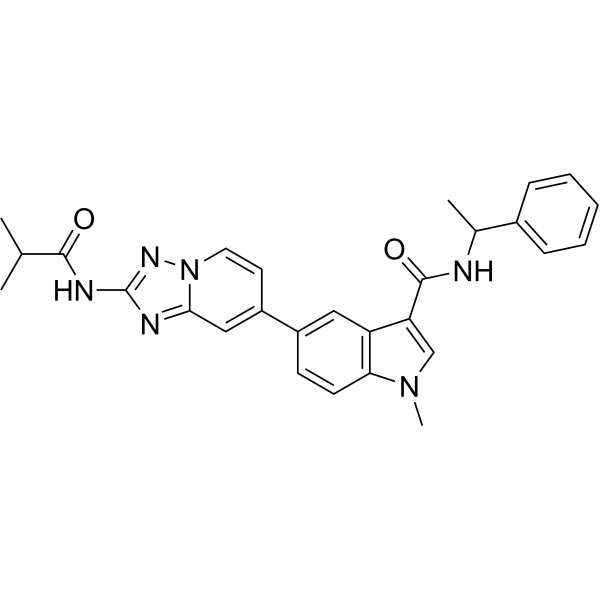| Description |
RI-962 is a potent and selective receptor-interacting protein kinase 1 (RIPK1) inhibitor. RI-962 inhibits RIPK1 with an IC50 value of 35.0 nM. RI-962 can be used for the research of nervous system diseases and inflammatory diseases[1].
|
| Related Catalog |
|
| Target |
IC50: 35.0 nM (RIPK1); EC50: 10.0 nM (HT29 cells), 4.2 nM (L929 cells), 11.4 nM (J774A.1 cells), 17.8 nM (U937 cells)[1].
|
| In Vitro |
RI-962 has potent inhibitory activity for RIPK1 with an IC50 value of 35.0 nM[1]. RI-962 has protective effect for necroptotic death with EC50 values of 10.0 nM, 4.2 nM, 11.4 nM, and 17.8 nM for HT29, L929, J774A.1, and U937 cells, respectively[1]. RI-962 (0-100 μM; 24 h) protectes cells from TSZ-induced necroptosis by inhibiting the kinase activity of RIPK1[1]. Cell Viability Assay[1] Cell Line: HT29, L929, J774A.1, and U937 cells Concentration: 0-100 μM Incubation Time: 24 h Result: Exerted a dose-dependent protective effect against necroptotic death. Western Blot Analysis[1] Cell Line: HT29 cells Concentration: 0-400 nM Incubation Time: Result: Markedly inhibited the phosphorylation of RIPK1 and its downstream signaling proteins RIPK3 and MLKL in a dose-dependent manner.
|
| In Vivo |
RI-962 (i.p.; 40 mg/kg; once a day for 10 day) ameliorates TNFα-induced SIRS and reduces inflammation in acute DSS-induced colitis[1]. Pharmacokinetic Parameters of RI-962 in rats (i.v., i.p., p.o.; 5, 20 mg/kg) [1]. RI-962 i.v. p.o. i.p. Dose (mg/kg) 5 20 20 T1/2 (h) 2.1 ± 0.2 1.3 ± 0.2 8.5 ± 1.6 Tmax (h) 0.1 ± 0.0 0.8 ± 1.0 0.5 ± 0.0 Cmax (ng/mL) 12170.4 ± 1198.5 674.2 ± 424.7 3603.3 ± 693.3 AUC0–t(ng*h/mL) 4526.1 ± 546.0 1594.9 ± 891.8 6459.7 ± 1131.6 AUC0–∞ (ng*h/mL) 4538.1 ± 546.3 1604.5 ± 896.1 6609.3 ± 1121.4 Vss (L/kg) 0.4 ± 0.1 - - MRT0–∞ (h) 0.4 ± 0.0 1.8 ± 0.2 2.8 ± 0.1 CL (mL/min/kg) 18.5 ± 2.1 - - F (%) - 8.8 ± 5.0 35.7 ± 6.3 Animal Model: C57BL/6 female mice[1] Dosage: 40 mg/kg Administration: Intraperitoneal for 15 min; once a day for 10 day Result: Ameliorated TNFα-induced SIRS by inhibiting RIPK1 activity. Suppressed the RIPK1 signaling in the mouse model of DSS-induced colitis. Animal Model: Sprague-Dawley (SD) rats[1] Dosage: 5, 20 mg/kg Administration: intravenous (i.v.) (5 mg/kg), intraperitoneal (i.p.) (20 mg/kg) and oral (p.o.) (20 mg/kg) Result: Had good metabolic stability in rats.
|
| References |
[1]. Yueshan Li, et al. Generative deep learning enables the discovery of a potent and selective RIPK1 inhibitor. Nat Commun. 2022 Nov 12;13(1):6891.
|


